Regardless of whether you plunge in warm or cold water, you should presumably wear a hood when diving. By protecting your heat-producing head, you will keep your entire body warmer and less weary. Choosing the best diving hood for you will impact your enjoyment as you explore the world under the waves.
The majority of diving hoods are composed of neoprene, which is a soft and pliable material. And because it is formed of numerous air bubbles, neoprene is a popular diving clothing material because it traps the heat produced by the diver’s body. In turn, the compressed heat warms the water trapped between the diver’s head and the neoprene.
| Diving Hoods | Brand | Our rating | Check Price on Amazon |
|---|---|---|---|
 | Skyone Thermal Diving Hood | [su_button url="https://www.amazon.com/Neoprene-Kayaking-Snorkeling-Swimming-Canoeing/dp/B07PYVCCWQ?tag=beka3687-20" target="blank" style="default" background="#E03F00" color="#FFFFFF" size="5" wide="no" center="no" radius="auto" icon="" icon_color="#FFFFFF" text_shadow="none" desc="" onclick="" rel="" title="" id="" class=""]Check Price[/su_button] | |
 | Dizokizo Neoprene Diving Hood | [su_button url="https://www.amazon.com/pandawoods-Wetsuit-Thermal-Neoprene-Diving/dp/B07F6XBLZV?tag=beka3687-20" target="blank" style="default" background="#E03F00" color="#FFFFFF" size="5" wide="no" center="no" radius="auto" icon="" icon_color="#FFFFFF" text_shadow="none" desc="" onclick="" rel="" title="" id="" class=""]Check Price[/su_button] | |
 | DiNeop Scuba Diving Hood | [su_button url="https://www.amazon.com/DiNeop-Neoprene-Stretchable-Snorkeling-Kayaking/dp/B07GZPLJP2?tag=beka3687-20" target="blank" style="default" background="#E03F00" color="#FFFFFF" size="5" wide="no" center="no" radius="auto" icon="" icon_color="#FFFFFF" text_shadow="none" desc="" onclick="" rel="" title="" id="" class=""]Check Price[/su_button] | |
 | A Point Diving 3mm Diving Hood | [su_button url="https://www.amazon.com/Point-diving-Dryhood-Wetsuit-Vented/dp/B0105FGOX6?tag=beka3687-20" target="blank" style="default" background="#E03F00" color="#FFFFFF" size="5" wide="no" center="no" radius="auto" icon="" icon_color="#FFFFFF" text_shadow="none" desc="" onclick="" rel="" title="" id="" class=""]Check Price[/su_button] | |
 | MioCloth Diving Hood Cap | [su_button url="https://www.amazon.com/MioCloth-Diving-Neoprene-Snorkeling-Wetsuit/dp/B07SK1CBCT?tag=beka3687-20" target="blank" style="default" background="#E03F00" color="#FFFFFF" size="5" wide="no" center="no" radius="auto" icon="" icon_color="#FFFFFF" text_shadow="none" desc="" onclick="" rel="" title="" id="" class=""]Check Price[/su_button] |
The Perfect Fit of a Diving Hood
A diving hood should fit snugly; if it is too loose, water will readily flow in and out of the hood. And because of the constant flow of water, your head will not be able to heat the water and keep it confined. The hood is too small if it causes uneasiness along the face or neck/throat. It is too large if water readily drifts in and out of the hood.
Some manufacturers feature zippers along the rear of the hood to make wearing and removing your diving gear easier. Many divers like this choice, which is especially popular among those with long hair.
Best Diving Hoods – Top 5 Choice
Our Number 1 Choice
[wp-review id=”3436″]
Our Runner-Ups
[su_service title=”Dizokizo Neoprene Diving Hood” icon=”icon: star” icon_color=”#2D3092″ size=”32″ class=””][/su_service]
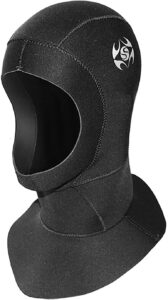
These diving hoods are constructed of 3mm superior eco-friendly neoprene and imported nylon. Good heat retention keeps you toasty when participating in aquatic activities. It is a thermal diving hood, which is an uncommon feature in any brand.
These surf hoods are bonded and blind stitched to avoid discomfort and offer optimum comfort and durability. They can efficiently reduce the amount of water that passes through the neoprene wetsuit hat. The incorporated flow vent allows bubbles to escape through the wetsuit hood’s top without promoting water exchange.
More crucially, the single-sided sponge in the inner face section makes the wet suit hood adhere to the face more tightly. You may trim the face seal to ensure that the diving hood properly fits your facial characteristics. This neoprene hood is ideal for sun protection and keeps you safe from sharp objects and marine irritants.
[su_service title=”DiNeop Scuba Diving Hood” icon=”icon: star” icon_color=”#2D3092″ size=”32″ class=””][/su_service]
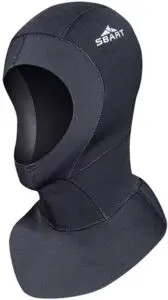
The DiNeop neoprene diving hood is made of 3MM quality neoprene. striving for a flexible, supple, and comfortable fit Its form-fitting design allows you to move freely during water activities, providing you with a terrific snorkeling and surfing experience.
This UV-protective diving hood will keep your head safe from sea lice, jellyfish, and corals. the Slip-on style with a smooth flat seam is sturdy for simple wear. It is bonded and blind stitched for improved strength and durability and has a high stretch and great recovery.
The brand believes it will be a long-term partner for you. The face seal may be cut by hand to exactly match individual facial characteristics.
[su_service title=”A Point Diving 3mm Diving Hood” icon=”icon: star” icon_color=”#2D3092″ size=”32″ class=””][/su_service]
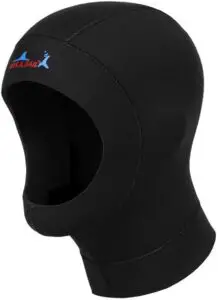
This diving hood is made of double-sided nylon fabric, has skin-friendly edges and seams, is soft but thick, and protects the head from coral abrasions, bruises, and other injuries.
While diving at any depth and any water temperature, you may set your head temperature and avoid heat dissipation. This keeps the head warm while also allowing for more activity flexibility. This diving head gives a more pleasant anatomical fit for you because it is freely contracted and composed of ultra-soft with 4-way stretch materials.
This Stretchable diving skins hat is simple to put on and remove. It should fit snug but not too tight around the dive mask or beneath the wetsuit.
[su_service title=”MioCloth Diving Hood Cap” icon=”icon: star” icon_color=”#2D3092″ size=”32″ class=””][/su_service]
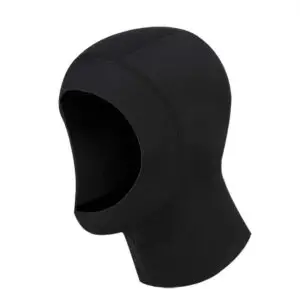
This diving hood is made of high-quality neoprene for a versatile and comfortable fit. You will have fewer constraints in the water, providing you with a more pleasant diving experience.
This surfing hood provides UV protection as well as protection against sea lice, and it is naturally form-fitting to prevent drag in the water. It is composed of quality thermal fabrics to keep you warm, so you can easily enjoy water activities. It is ideal for diving, surfing, snorkeling, swimming, scuba diving, oyster diving, sailing, kayaking, and other water activities.
All of your water activities will be more enjoyable than ever before thanks to the use of this diving hood, which comes at a reasonable price.
Choosing the Suitable Diving Hood for you
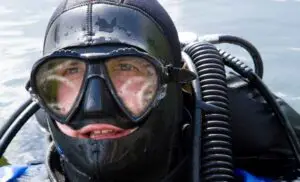
Photo Credits: Divein
Hoods function similarly to caps in that they trap heat before it exits your body. Diving hoods are more refined than your typical winter hat. A tiny amount of water is also trapped around the diver’s head by the hood.
The diver’s body heat heats the water trapped in the diver’s hood, keeping him warm and comfortable. It is necessary to comprehend how to select and what to look for in a diving hood.
❕ The Warmth
Of course, if you plunge in cold water, you’ll need a warmer hood or a diving hood that maintains your warmth. If you are dipping in chilly water, seek thicker neoprene diving hoods. A 7mm diving hood, for instance, will hold you significantly warmer than a 3mm diving hood.
A 3mm hood composed of nylon or neoprene is normally only suited for warm-water diving.
❕ The Coverage
The more of your front your hood shelters, the warmer you will be. Coldwater dive hoods feature bibs that tuck into the wetsuit. Cold-water diving hoods also shield a large portion of the diver’s cheeks, mouth, chin, and forehead, exposing very small of the face to the cold.
To remain warm while diving in cold water, seek a big bib with maximum coverage. If you’re diving in warm water, you won’t require or desire extra protection. In fact, covering less of your face will increase your movement and maybe your peripheral vision.
❕ The Movement
If you’re diving in frigid water, your major concern will be staying warm. If you are diving in warm water, though, you can contemplate movement. Look for hoods that enable you to move more freely. Nylon hoods allow for the most mobility in warm water.
❕ The Fit
In order to work properly, your hood must fit properly. Your neck, throat, and face will be strained if your diving hood is too small. This is not only unpleasant, but it may also be distracting and restrict natural movement during a dive.
Water will readily flow in and out of your diving hood if it is too big. This will prevent your hood from efficiently trapping heat. A too-large hood is harmful on a cold-water dive since it will just not keep you warm enough.
❕ The Zippers
Not all diving hoods have zippers, although some do have zippers around the back. If you have long hair, you should seek a diving hood in this design.
Zippers make wearing on and taking off your diving hood simpler. Zippers can also assist prevent the hood from tying on your hair whether you’re putting on or taking off your diving hood.
Checklist When Scuba Diving
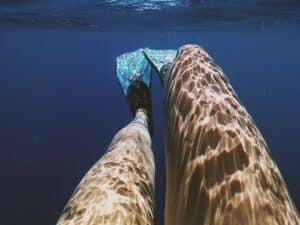
Scuba diving is unquestionably a popular water sport, particularly for people who want to discover the ocean’s hidden beauties. It does, however, need some planning.
Before you can try a secure and pleasurable dive into the deeps of the ocean, you must first acquire the physical mastery, understanding, and technical exercise needed to perform a thriving dive.
✔️A Diving Mask
Human eyes were not built to perform well in water, especially saltwater. As a result, one of the most critical items you will want is a diving mask. A cozy, high-quality mask might be the difference between boring dives and a good time underwater.
If you desire total comfort throughout your dive, it is essential to get a new one that fits you exactly and fulfills your specific demands.
✔️A Drysuit or a Wetsuit
Though carrying a drysuit or wetsuit is cumbersome because of its weight, it is extremely necessary for defending your skin and maintaining you warm.
It is often constructed of neoprene rubber, which serves as cushioning by trapping a thin layer of water beside the skin. If the water is cooler, you’ll need a heavier wetsuit or drysuit.
✔️Fins
Fins are another essential piece of diving equipment. They give you power over your flow and permit you to move quickly and easily through the water. On the market, there are two types of scuba fins: open heel and whole foot fins.
Within those two categories, there are two further types to select from blade or split. When shopping for scuba diving fins, efficiency and comfort are critical, so do your homework before purchasing a set.
✔️Scuba Gloves
Scuba or diving gloves are composed of tough, long-lasting materials that assist avoid skin abrasion and punctures when exploring underwater caverns and other difficult diving situations.
They function similarly to a wetsuit by entangling a small layer of water between the skin and the material to decrease heat loss. These gloves not only rescue your fingers and palms but also keep your hands toasty underwater.
✔️A Scuba Tank
A scuba tank, also known as a diving cylinder, is another piece of equipment that you will require when diving. It is a part of your breathing equipment that allows you to store and transfer vast amounts of basic compressed air or specialist gas combinations like Nitrox.
✔️A Regulator
By turning high-pressure air into ambient pressure, the regulator allows you to breathe the air from your tank. It has a first step, which links to the tank or diving cylinder you have on your back, and a second step, which is the component of the regulator you place in your mouth.
It also features gauges and a backup second stage. When selecting a diving regulator, choose one that provides the maximum degree of comfort and performance for your specific demands.
✔️Navigators
During a dive, a depth gauge records the current and maximum depth achieved. Meanwhile, a submersible force gauge shows how much gas is left in your scuba tank or cylinder, which can assist you to check your gas supply during your dive.
A compass is also necessary for accurate dive navigation. Knowing where you are during a dive is necessary, especially in restricted visibility. It saves you from becoming lost, and it also keeps you from worrying and expending more air than necessary.
✔️A Dive Computer
The goal of this equipment is to determine how long you’ve been underwater, how deep you are now, and how long you can stay at that depth. A dive computer, in addition to the three previously stated components, can be utilized to guarantee a safe and smooth dive.
Renting a dive computer might be more expensive, therefore it’s frequently wiser to buy one instead.
✔️A Buoyancy Compensator
The buoyancy compensator, also known as a buoyancy control device, prevents you from floating to the surface or sinking to the seafloor. It’s essentially a vest or jacket that you wear when diving to assist regulate your buoyancy.
Aside from letting you adjust your buoyancy, various buoyancy compensators may also contain compartments and straps that enable you to secure all of your critical scuba diving equipment.
✔️A Snorkel
Divers are instructed to bring a snorkel with them on their dives, although for more experienced divers, it’s mainly a question of personal taste.
Whether or not you consider a snorkel to be required for your personal dive, it may be a crucial piece of safety equipment for novice or less experienced divers, and it can be beneficial when you don’t want to use up valuable air from your tank.
Diving Safety Precautions
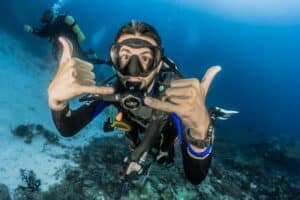
Scuba diving is becoming a more common activity for individuals all around the world. While it is a generally safe hobby when done appropriately, there are a few hazards involved.
Fortunately, these hazards are virtually always avoidable if you follow some basic scuba diving safety precautions.
➖Obtain Certification
Scuba diving has hazards, which is why it needs specialized training. Divers learn about diving concepts and build skills by diving in both restricted and open water conditions using a curriculum provided by recognized diving agencies.
The safety data is presented in levels, and divers will know about the specific hazards associated with each diving level they wish to receive and how to deal with them.
➖Maintain your Health
One of the most overlooked safety checks before a dive is making sure you’re in good health. Some medical disorders are incompatible with diving, so it’s a good idea to get yourself tested on a regular basis to ensure you’re in great shape.
➖Check Your Equipment Again
Whether you own or rent your equipment, always do a safety check before each dive. Examine it for signs of wear and tear, such as malfunctioning zippers, fractured buckles, and straps, or frayed spots that might result in leaks.
Your regulator and tank should also be tested for functionality on a regular basis.
➖Understand your Limits
Divers should always stay inside their comfort zone. Do not dive if you have not yet acquired the necessary set of abilities for a certain type of dive or if you do not feel mentally and physically capable of doing so. It’s no shame in revoking a dive or adjusting the dive site to a more relaxed setting.
➖Bring a Friend
Diving with a companion is one of the finest scuba diving safety precautions. All divers should be able to take maintenance of themselves, but it never hurts to have an additional set of eyes and hands, as well as an extra regulator, in case of an emergency.
➖Don’t Hold Your Breath
One of the most important protection guidelines is to breathe at all times. Divers are frequently compelled to hold their breath underwater, but doing so can be exceedingly dangerous.
The deeper you go, the higher the water pressure and the lower the capacity of the lungs. When you rise, your lungs expand, and the air in your lungs becomes dangerous.
➖Don’t Interfere with Marine Life
Many of the marine critters you’ll see on your dives are delicate organisms that may be harmed by a light touch. There are additional fish species that release mucus as a protective barrier against their surroundings. By touching them, you compromise their protection, making the fish exposed to infection.
➖Regularly Inspect your Gauges
Monitoring the pressure gauges is another important scuba diving safety tip to be aware of. It may seem apparent, yet it is easy to overlook. You can only stay underwater as long as there is air in your tank.
It’s unlikely that you’ll run out of air if you monitor your pressure gauge and surface with a healthy reserve of air in your tank.
Frequently Asked Questions
Q: What exactly is a diving hood?
A: It gives you support and security while you traverse the underwater environment. It can also aid in keeping the heat in your head to ensure a pleasant dive.
Q: How do I select a dive hood?
A: A dive hood should fit snugly. Water will be able to readily flow in and out of a hood if it is too loose. Because of the constant flow of water, your head will not be able to heat the water and keep it confined.
Q: What is the ideal fit for a diving hood?
A: A dive hood should be tight but has enough space for you to move freely.
Q: Is the wetsuit hood worn over or beneath the wetsuit?
A: A wetsuit hood is an excellent complement to your primary wetsuit. It is made up of a neoprene head covering that covers your head and neck, leaving only your face exposed.
Q: Is a diving hood required?
A: Despite whether you dive in warm or cold water, you should probably wear a hood when diving.
Final Thoughts
Diving hoods provide several advantages. It not only protects you from any cuts or lice when diving, but it also preserves body heat. The above-mentioned items are among the best on the market. We have reduced it down for your convenience alone. It is also critical to understand how and what to look for in a diving hood. There are several designs and features available. It is critical to select one that will make you feel at ease.
